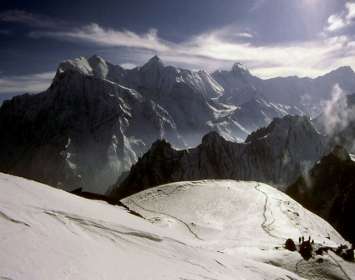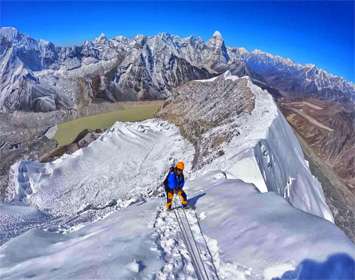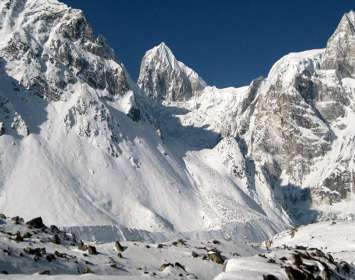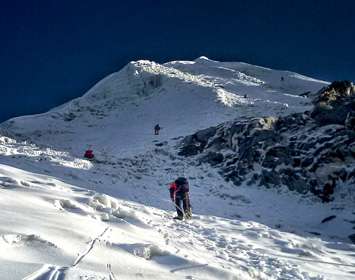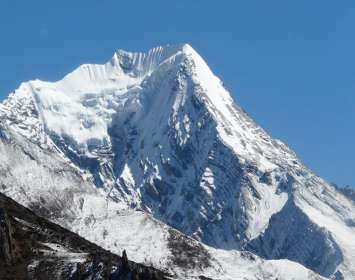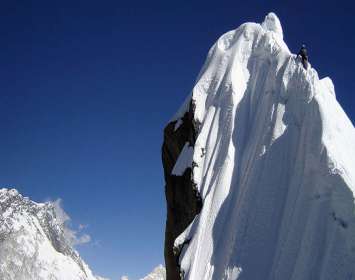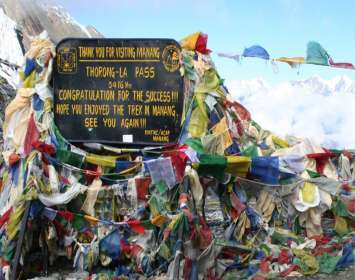Good to Know
Best time to go Kyajo Ri Peak Climbing
Spring i.e. March to May and Autumn i.e. October to November is the best time to go on Kyajo Ri Peak Climbing. These are the peak time of the year to do climbing in the Himalayas. The weather mostly remains stable with moderate climate and stunning views. Other seasons like winter and monsoon is not a good time to go on Kyajo Ri Peak Climbing due to bad weather and unclear view.
Kyajo Ri Peak Climbing difficulty
Climbing Kyajo Ri Peak is difficult as it involves technical climbing and unique terrain. Before reaching the summit, you have to cross the glacier, crevasses, and steep ice wall. On a daily basis, you have to walk for 6 to 7 hours, which requires good health and physical fitness. Kyajo Ri Peak Climbing demands previous trekking experience in high altitude along with strong stamina, determination, and will-power to reach the top of the peak.
Altitude Sickness Symptoms & Prevention
Kyajo Ri Peak Climbing takes you above 6,000 meters. Acclimatizing your body with the altitude as you move forward is very important in high altitude journey to avoid Acute Mountain Sickness (AMS). It is also known as altitude sickness that can happen to anyone. We have added ample rest days in our Kyajo Ri Peak Climbing itinerary to give you enough time to adjust to the altitude.
Below you can read about symptoms and prevention of altitude sickness:
Symptoms of altitude sickness:-
- headache
- nausea and vomiting
- dizziness
- tiredness
- loss of appetite
- shortness of breath
Prevention of altitude sickness:-
- Include an adequate number of rest days during the trek/climbing
- Avoid climbing more than 300-500 meters a day
- Make sure you're drinking enough water
- Eat a light but high-calorie diet
- Avoid alcohol
- Avoid smoking
- Inform your guide immediately so that he can take proper action on time
- Drop down to lower altitude and rest for a few days until symptoms getaway
Food & Water during Kyajo Ri Peak Climbing
You can choose meals from the menu of the lodge. They offer a wide variety of dishes ranging from Nepali, Indian, Tibetan to Continental. Among all the options, dal bhat tarkari is the most filling, delicious, and affordable one. You will find both the veg and non-veg option in it. Other dishes like sandwiches, pizza, pasta, momo, veggies, curries, chapati, porridge, pudding, bread, eggs, etc are also available.
While staying in camp, the meals will be cooked by our trained porters. We offer delicious and healthy meal options. Drinking water is available everywhere. Make sure to carry a water purification tablet to double purify water. During camping, we will provide you pure drinking water.
Accommodation during Kyajo Ri Peak Climbing
The lodge will be the main accommodation while you stay overnight in the village. These lodges are operated by locals that help them earn a living. The facilities in the lodge are basic. You will get a twin sharing room with private/common washrooms. The rooms are not huge in size and are also not properly insulated, therefore we suggest you carry a nice sleeping bag. The dining area is more like a common space where you can have snacks and warm up yourself.
During climbing, you will stay overnight in tents. We offer very good quality tents for sleeping, dining, and washroom. All the members of the group will get individual tents for sleeping. We will carry the tents and other equipment with us.
Kyajo Ri Peak Climbing cost
The climbing cost for Kyajo Ri Peak includes things like accommodation, meals, ground transportation, permits, and expenses of guide & porter. You will find the most comprehensive Kyajo Ri Peak Climbing cost with top-notch service from us. We have designed our Kyajo Ri Peak Climbing itinerary carefully to make sure you are enjoying every bit of the trip. If you are thinking of doing any changes in the itinerary then package cost will also get changed.
Environmental Practices
We practice several measures to not damage the environment during our trips. We have planned our trip adopting the best sustainable equipment that we can use for the long term. While returning from the camps, we collect all the garbage and encourage our guests to not leave any waste on the base camps. Likewise, we also suggest our guests use reusable containers for water or any other things. We also work closely with the locals of every region and help them providing earning opportunities.
Kyajo Ri Peak Climbing Packing List
We want you to know that you can rent or buy all the gears in Kathmandu. There are several options from medium range brands to high-end brands for all budget types.
- Clothing
- Sun hat/scarf
- Fleece jacket with wind-Stopper
- Waterproof shell jacket
- Down vest and/or jacket
- Lightweight gloves/Heavyweight gloves or mittens with a waterproof shell outer
- Light and expedition weight thermal bottoms
- Fleece/wool pants
- Waterproof (preferably breathable fabric) shell pants
- Thick, warm wool hiking socks
- Hiking boots with spare laces
- Sunglasses with UV protection
Accessories
- Sleeping bag rated to zero degrees Fahrenheit
- Trekking poles
- Headlamp
- Trek bag-pack
- Basic First Aid Kit
- Daypack
- Thermo-rest sleeping pad
- Water bottles
Climbing gears
- Climbing harness
- Ice ax
- crampons
- Mountaineering boots
- AscenderDescender/Abseil device
- Rope
- Snow bar
- Ice hammer
- Helmet (optional)
Toiletries
- Quick-drying towel/Small wash towel
- Soap (biodegradable)
- Toothbrush/paste biodegradable)
- Deodorants
- Face and body moisturizer
- Nail clippers
- Small mirror
- Tissue paper/toilet roll
- Anti-bacterial Hand wash
Extra
Trail Map/Guide book
Binocular
Reading book
Journal & Pen
Pencils and small notebooks
Camera with extra batteries

